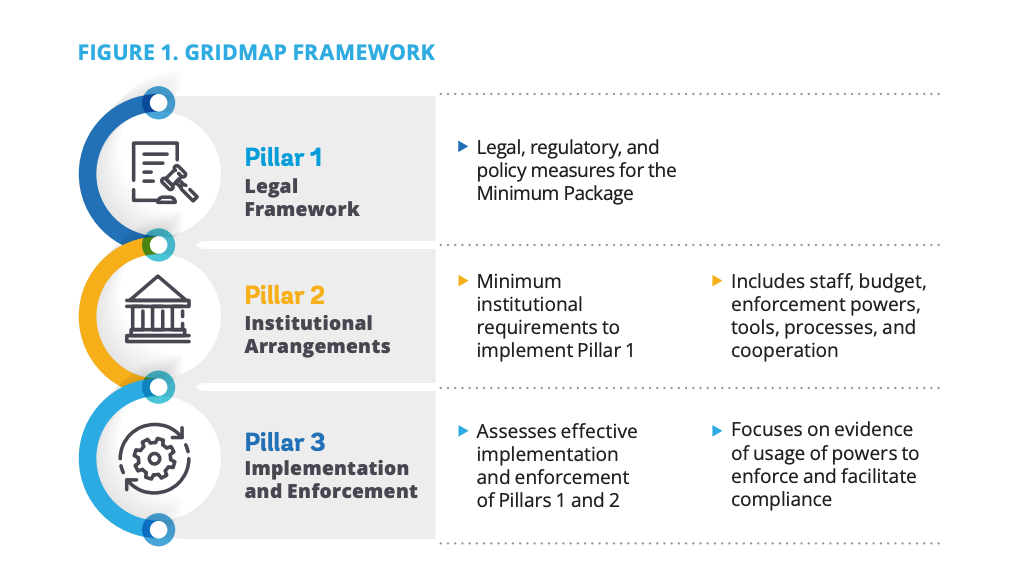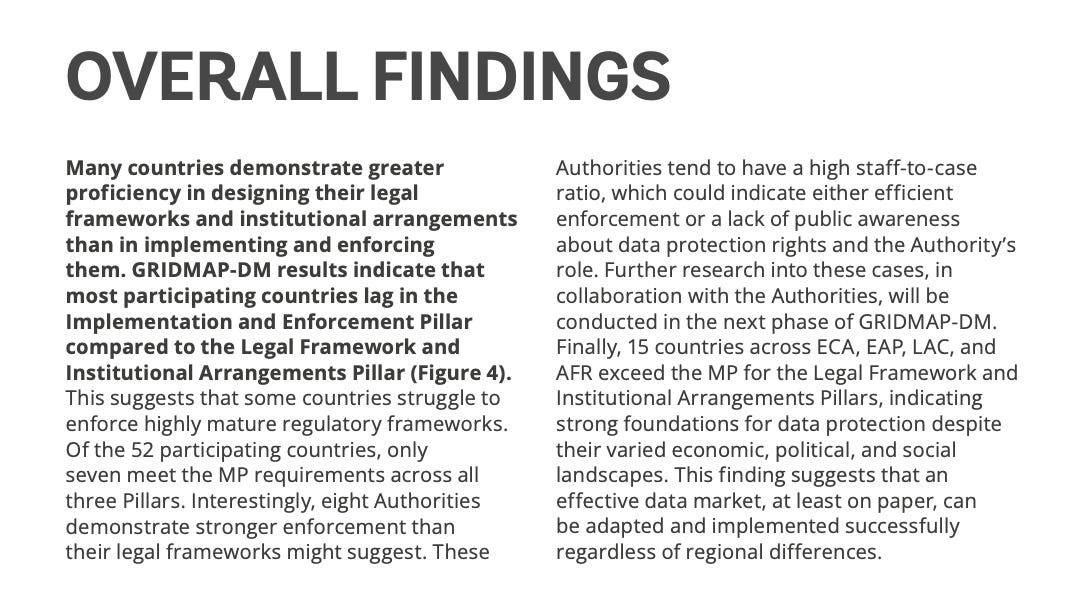Policy Update: A Scorecard For Digital Market Governance
The World Bank GRIDMAP’s MAP helps countries measure regulatory strength, build institutions, enforce laws, and create safer digital markets.
Most governments talk tough on digital markets yet deliver fragile rules and weak institutions without proper enforcement mechanisms. The World Bank’s GRIDMAP exposes these gaps with a hard scoring system that strips away excuses. Regulators can no longer hide behind lip service. Markets need action, not declarations, and this GRIDMAP framework shows who is serious and who is not.
In this newsletter, we will cover:
Why the World Bank’s GRIDMAP Toolkit matters for every country trying to protect consumers, regulate data markets, and create trustworthy institutions that can actually enforce the rules they write.
How the Maturity Assessment Profile (MAP) measures regulatory progress, from nascent beginnings to advanced readiness, and why this scoring system gives governments no excuse to hide weak laws or poor enforcement.
The practical tools inside GRIDMAP that help policymakers and regulators compare themselves to peers, identify gaps, and take concrete actions that strengthen markets, lower compliance costs, and build genuine trust with businesses and citizens.
The urgent lessons for digital markets: without robust legal frameworks, capable institutions, and visible enforcement, rules are meaningless, and how GRIDMAP offers a structured pathway to close these gaps before abuse and fraud spread further.
GRIDMAP
The World Bank has released a new methodology designed to help countries understand how prepared they are to regulate digital and traditional markets in ways that protect consumers, strengthen institutions, and ensure enforcement.
The framework is called the Global Regulations, Institutional Development, and Market Authorities Perspective Toolkit, or GRIDMAP.
At the centre of this framework sits the Maturity Assessment Profile, known as MAP.
The idea behind GRIDMAP is straightforward but powerful.
Emerging markets and developing economies often face similar challenges: uneven legal frameworks, weak institutions, and inconsistent enforcement.
These gaps make it difficult to foster trust in markets, particularly in areas like consumer protection and data governance.
GRIDMAP provides a minimum package of rules, institutions, and practices that any country can aim for, and MAP provides the methodology to measure how close a country is to achieving that package.
Rather than offering a single set of fixed rules, GRIDMAP acknowledges that every country will travel its own path.
It provides a structured way to identify where strengths exist, where weaknesses remain, and where reforms might deliver the greatest benefits.
The Three Pillars of GRIDMAP
The framework rests on three pillars. Each one is necessary, but none is sufficient alone.
Together, they create the minimum package for building safe and trustworthy markets.

Pillar One: The Legal Framework
Countries need laws and regulations that clearly define rights, obligations, and standards. These are the building blocks of a contestable market where participants understand the rules.
Pillar Two: Institutional Arrangements
Having laws on paper is not enough. Authorities must exist to implement those laws, staffed with adequate resources, empowered with clear roles, and capable of cooperating across borders.
Pillar Three: Implementation and Enforcement
Authorities must use their powers consistently and visibly. Trust only grows when participants see rules enforced, breaches addressed, and compliance facilitated.
Each pillar feeds into the others.
Laws without institutions remain symbolic. Institutions without enforcement lack authority. Enforcement without clear legal foundations risks arbitrariness.
GRIDMAP’s strength is to hold these three together.
Tools to Build Capacity
GRIDMAP provides seven tools that countries can use in a modular way. At the heart is the definition of the Minimum Package.
This package represents international good practices but is flexible. It is not a single threshold, but a range of acceptable outcomes.
A country might meet the lower range of the package and still have space to reach more advanced practices in the upper range.
The other tools help gather data, populate a global database, conduct assessments, and create dashboards for comparison.
Importantly, GRIDMAP also maintains a Bank of Good Practices, offering examples of how different authorities around the world have solved similar problems.
MAP: The Maturity Assessment Profile
The MAP methodology translates this framework into a practical assessment. It divides maturity into four levels.
Nascent (0–24 percent of possible points): Early stages, missing many key regulatory elements. Trust is limited, and international alignment is minimal.
Developing (25–49 percent): Progress is underway, with partial frameworks and some growing trust.
Emerging (50–74 percent): Most regulatory components are in place, market trust has improved, and alignment with international standards is significant.
Advanced (75–100 percent): Full frameworks exist, practices are robust, and the country participates in setting international standards.

This clear structure matters because it avoids the trap of viewing regulatory development as binary.
It is not a question of having a law or lacking one. Instead, it measures progress across pillars, categories, and components.
How the Methodology Works
The assessment follows a detailed process.
First, weighted scores are calculated for each component.
Not all elements are equally important, so weights reflect expert views gathered from regulators, international organizations, and academic specialists.
Categories are then scored, normalized, and aggregated into pillar scores.
Second, the results are compared to the Minimum Package.
A country that reaches at least half of the maximum points in a category or pillar is considered to have reached the lower range of the package.
Reaching the upper range signals a higher level of maturity.
Third, maturity levels are assigned. Each pillar, category, and component is placed into one of the four levels.
Fourth, results are visualized in graphs.
For example, a country’s institutional arrangements in data markets can be compared with its peers in the same region or income group.
These visual comparisons make it easier to identify strengths and challenges.
Finally, authorities interpret results.
They can see which components are above the benchmark and which are lagging.
For example, a country may score well in personal data breach responses but remain weak in cross border cooperation or financial resources.
This nuanced view helps target reforms.
Why MAP Matters for Digital Markets
The document emphasizes consumer protection and data markets as priority modules.
This focus is deliberate.
In many developing economies, consumers face significant risks: excessive data collection, bias from automated decision making, unfair commercial practices, fraud, and breaches of data security.
Small and medium enterprises also face difficulties because of information gaps and power imbalances with larger firms.
Without credible regulation, trust falters, and markets stagnate.
MAP allows countries to measure their progress against global standards and identify practical steps forward.
For a regulator, this can mean knowing whether to prioritize strengthening enforcement, building institutional resources, or aligning legal frameworks with international norms.
Practical Implications for Policymakers and Practitioners
Benchmarking Performance: Countries can use MAP to see where they stand compared to peers. This evidence allows policymakers to communicate clearly with citizens, businesses, and international partners.
Prioritizing Reforms: Because MAP highlights specific gaps, resources can be directed efficiently. For example, if clear processes or cross border cooperation score low, targeted reforms can be designed.
Enhancing Trust: Transparency in assessment increases market confidence. When participants see evidence based evaluations, they are more likely to trust institutions and engage in markets.
Encouraging Collaboration: The framework allows countries to learn from one another. By looking at the Bank of Good Practices, authorities can adopt proven solutions rather than starting from scratch.
A Toolkit for Everyone
For readers outside government, GRIDMAP and MAP may seem technical. Yet the principles are universal.
Trust in markets matters to every consumer.
When institutions lack capacity, individuals suffer from fraud, misuse of personal data, or weak protection.
When enforcement is absent, rules become meaningless.
The MAP methodology offers a pathway for governments to diagnose weaknesses, but it also creates expectations for transparency.
Citizens and businesses can demand to know where their country stands.
Policymakers can no longer claim progress without evidence.
The GRIDMAP methodology is still developing.
Over time, feedback from regulatory authorities and experts will refine the components and expand the modules.
As this occurs, countries will have access to more precise assessments, more detailed comparisons, and more actionable recommendations.
What remains constant is the goal: to provide emerging markets and developing economies with a credible, evidence based toolkit for building safe, trustworthy, and competitive digital markets.
As digitalization deepens across the globe, the need for trustworthy regulation only grows.
GRIDMAP and MAP provide countries with the means to assess themselves honestly, learn from one another, and take concrete steps toward stronger institutions and safer markets.
Your views on how regulatory maturity should be assessed, communicated, and applied are invaluable. I invite you to share your thoughts, experiences, or questions in the comments.




Relying on guidelines from relevant international bodies on how to regulate, supervise, and operationalize innovative markets can be a great starting point for discussing legal/regulatory developments or updates. I wasn’t familiar with GRIDMAP, and I believe there is room to use it as a reference/market best practice in the governance structures of companies operating in digital markets, as well as in sectoral discussions that may influence future advocacy efforts.
Thank you for sharing!